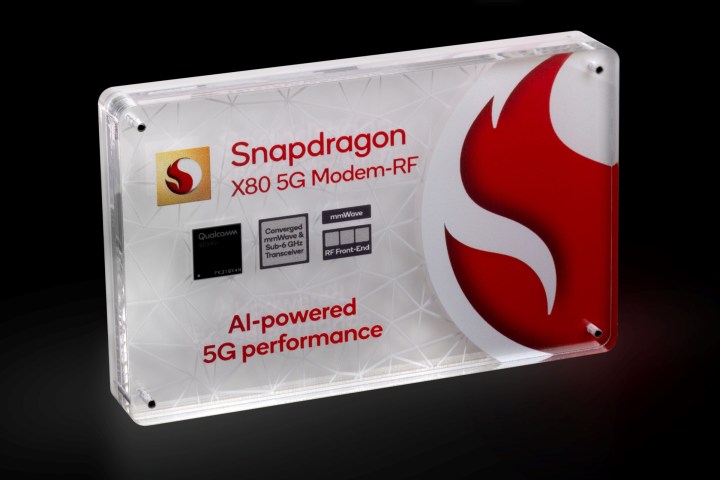
It’s that time of year again when Qualcomm ushers in its next generation of 5G modem technology. Announced at Mobile World Congress (MWC ) 2024, this year’s Snapdragon X80 5G Modem-RF system is the successor to last year’s Snapdragon X75, and it builds on the 5G Advanced foundation laid last year with more raw power and new AI features.
While the Snapdragon X75 moved the needle by adding support for the latest 5G Advanced standards, we’re still in that fourth phase of 5G technology, otherwise known as 3GPP Release 18 — and most carrier networks are still catching up. So, with no new standards to embrace, Qualcomm has focused on improving the inside of the Snapdragon X80 to take even fuller advantage of these cutting-edge 5G technologies.
The magic of AI-powered 5G
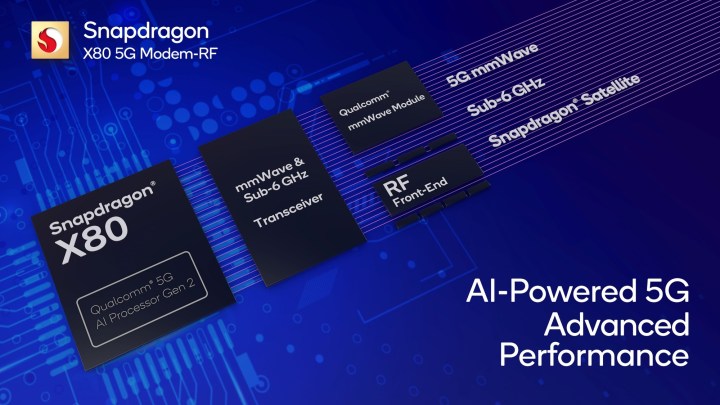
Qualcomm’s latest Snapdragon 8 Gen 3 chip uses last year’s Snapdragon X75 modem. While it packs in new generative AI capabilities, those are focused on powering things like Samsung’s Galaxy AI suite of user-facing features found on this year’s Galaxy S24 lineup.
Qualcomm dabbled with some AI features in the X75. But by adding a dedicated AI tensor accelerator to the chip for the first time, the Snapdragon X80 is Qualcomm’s first attempt to truly harness the power of AI to dynamically tune how a 5G modem works. This year’s AI tensor accelerator powers the Qualcomm 5G AI Suite Gen 3, which the company says “intelligently enhances data speeds, quality of service (QoS), latency, coverage, and power efficiency.” In other words, all the things that make a 5G chip deliver top-notch performance.
Specifically, the AI will handle things like network selection to ensure that your smartphone or other device is more likely to link up with the best towers and bands, as well as more intelligently balance power efficiency and fast performance with on-device machine learning that analyzes how you use your device and the 5G networks and frequencies that typically surround you.
For example, while it makes sense to connect to the nearest 5G tower when your smartphone is dormant, during periods of peak congestion, it can take more power to get the kind of 5G speeds you need for streaming 4K video or transferring large files. In those scenarios, connecting to a less busy tower that’s farther away can be more efficient and save battery life.
While most 5G modem systems are already designed to account for things like this, they’ve traditionally been based on static rules designed for the most common scenarios, but lack the flexibility to deal with the relatively unpredictable world of 5G networks and the people who use them. Qualcomm’s 5G AI Suite promises to help a new generation of smartphones adapt to this ever-changing 5G landscape.
“Leveraging AI is critical to the future of connectivity,” said Durga Malladi, Qualcomm’s senior vice president and general manager of technology planning and edge solutions, adding that “this latest milestone underscores Qualcomm Technologies’ leadership at the intersection of cutting-edge AI and advanced modem-RF technology.”
Upping the game for 5G Carrier Aggregation
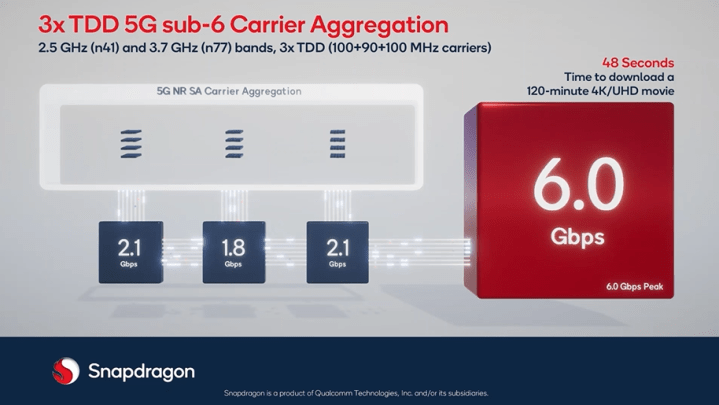
Speeds on 5G networks have hit something of a plateau, forcing network engineers to devise new and creative ways of getting the best speed over the longest range. While many once believed that extremely high-frequency mmWave networks would be the solution, those turned out to be cost-prohibitive due to the disappointingly limited range of those frequencies and the staggering number of transceivers that would need to be deployed to provide adequate coverage over a large area.
The result is that most carriers have now set up camp in the midband frequencies, and while those deliver an excellent range-to-speed ratio, they still have their limits. Hence, companies like T-Mobile have been turning to 5G Carrier Aggregation (5G CA), which combines multiple 5G frequencies to boost speeds into the gigabit-per-second ranges.
Of course, 5G CA on the carrier side is useless unless client devices support it, and that’s where Qualcomm’s latest 5G Advanced chips come in. Last year’s Snapdragon X75 already offered five-carrier aggregation on sub-6GHz frequencies, meaning T-Mobile customers with a Samsung Galaxy S24 should already be experiencing faster speeds.
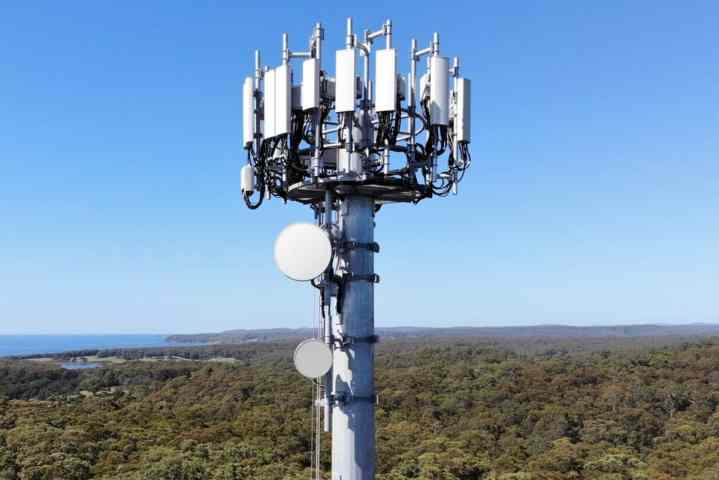
The Snapdragon X80 will now push that to new heights with 6X downlink carrier aggregation and a six-antenna architecture. This means smartphones equipped with that chip will be capable of receiving data on six separate 5G frequencies simultaneously at maximum speeds. While T-Mobile isn’t quite there yet — it only has four-carrier aggregation right now — it could very well expand that by the time the first X80-powered devices land in North America early next year.
Oddly, the Snapdragon X80 also still supports Snapdragon Satellite, which may lead some to believe that the reports of its demise have been exaggerated. However, Qualcomm isn’t talking about it much this year other than to say that the X80 is the first 5G modem to get fully integrated support for Narrowband Non-Terrestrial Network (NB-NTN) satellite communications, suggesting that Qualcomm may be preparing to take another kick at the can with a more open standard. The original Snapdragon Satellite was a proprietary Qualcomm technology, but after its agreement with satellite provider Iridium fell apart last year, it promised to focus its efforts on standards-based solutions.
Covering the entire spectrum
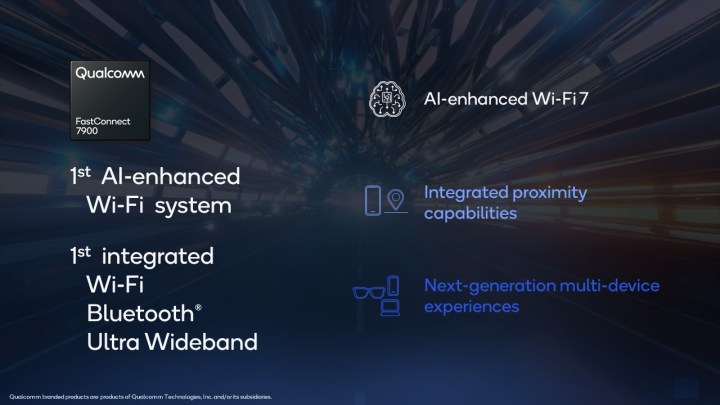
Alongside the Snapdragon X80 Modem-RF system, Qualcomm has also unveiled the FastConnect 7900, a new Wi-Fi 7 processor that integrates not only Bluetooth, but also Ultra Wideband technologies on a single chip while also leveraging new AI technologies to maximize performance and reduce latency and power consumption.
Like the X80, the FastConnect 7900 uses machine learning AI to optimize performance by helping it adapt to the way you’re using your device and the environment you’re in. This reduces power consumption and promises to deliver extremely low latency on Wi-Fi networks and new High Band Simultaneous technology that can provide seamless and near-instantaneous movement of whatever you’re watching or working on from your phone to your TV to your PC.
The integrated Ultra Wideband adds proximity to the mix, taking Snapdragon Seamless and Qualcomm’s Expanded Personal Area Network (XPAN) to a whole new level.
“FastConnect 7900 is a technological feat, leveraging AI to raise the bar and deliver leading Wi-Fi 7 and Bluetooth capabilities while integrating Ultra Wideband all on a single 6nm chip,” said Javier del Prado, Qualcomm’s vice president and general manager for mobile connectivity. “The system brings next-level capabilities across AI, proximity, and multi-device experiences into the devices we love most.”
The Snapdragon X80 Modem-RF System and FastConnect 7900 are both expected to launch commercially in the second half of 2024, with the first smartphones and other devices featuring them likely to arrive toward the end of the year.
Editors' Recommendations
- This tiny dongle will change 5G connectivity forever
- Here’s how fast 5G on your Samsung Galaxy S23 really is
- Qualcomm’s Snapdragon X35 will bring 5G to your next smartwatch
- The most exciting 5G technology to come out of MWC 2022
- Qualcomm’s Snapdragon X70 modem pushes 5G to new heights





